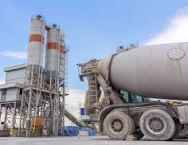Compaction
The operation of placing and compaction are interdependent and are carried out simultaneously. They are most important for the purpose of ensuring the requirements of strength, impermeability and durability of hardened concrete in the actual structure. As for as placing is concerned, the main objective is to deposit the concrete as close as possible to its final position so that segregation is avoided and the concrete can be fully compacted. The aim of good concrete placing can be stated quite simply.
It is to get the concrete into position at a speed, and in a condition, that allow it to be compacted properly. To achieve proper placing following rules should be kept in mind:The concrete should be placed in uniform layers, not in large heaps or sloping layers.The thickness of the layer should be compatible with the method of vibration so that entrapped air can be removed from the bottom of each layer.The rate of placing and of compaction should be equal. If you proceed too slowly, the mix could stiffen so that it is no longer sufficiently workable. On no account should water ever be added to concrete that is setting. On the other hand, if you go too quickly, you might race ahead of the compacting gang, making it impossible for them to do their job properly. Each layer should be fully compacted before placing the next one, and each subsequent layer should be placed whilst the underlying layer is still plastic so that monolithic construction is achieved. Collision between concrete and formwork or reinforcement should be avoided.For deep sections, a long down pipe ensures accuracy of location of concrete and minimum segregation.You must be able to see that the placing is proceeding correctly, so lighting should be available for large, deep sections, and thin walls and columns.Once the concrete has been placed, it is ready to be compacted. The purpose of compaction is to get rid of the air voids that are trapped in loose concrete.
It is important to compact the concrete fully because:Air voids reduce the strength of the concrete. For every 1% of entrapped air, the strength falls by somewhere between 5 and 7%. This means that concrete containing a mere 5% air voids due to incomplete compaction can lose as much as one third of its strength.Air voids increase concrete's permeability. That in turn reduces its durability. If the concrete is not dense and impermeable, it will not be watertight. It will be less able to withstand aggressive iquids and its exposed surfaces will weather badly.Moisture and air are more likely to penetrate to the reinforcement causing it to rust. Air voids impair contact between the mix and reinforcement (and, indeed, any other embedded metals). The required bond will not be achieved and the reinforced member will
25 * Under revision
not be as strong as it should be.Air voids produce blemishes on struck surfaces. For instance, blowholes and honeycombing might occur. There are two methods for compaction which includes: vibration by vibrators or by tamping using tamping rods.
Curing
Curing is the process of making the concrete surfaces wet for a certain time period after placing the concrete so as to promote the hardening of cement. This process consists of controlling the temperature and the movement of moisture from and into the concrete.
Curing of concrete is done for the following purposes. Curing is the process of controlling the rate of moisture loss from concrete to ensure an uninterrupted hydration of Portland cement after concrete has been placed and finished in its final position.Curing also helps maintain an adequate temperature of concrete in its early stages, as this directly affects the rate of hydration of cement and eventually the strength gain of concrete or mortars.
Curing of concrete must be done as soon as possible after placement and finishing and must continue for a reasonable period of time, for the concrete to achieve its desired strength and durability.Uniform temperature should be maintained throughout the concrete depth to avoid thermal shrinkage cracks.
Material properties are directly related to micro-structure. Curing assists the cement hydration reaction to progress steadily and develops calcium silicate hydrate gel, which binds aggregates leading to a rock solid mass,makes concrete denser, decreases the porosity and enhances the physical and mechanical properties of concrete.
Some other purposes of curing can be summed up as: curing protects the concrete surfaces from sun and wind, the process of curing increase the strength of the structure, the presence of water is essential to cause the chemical action which accompanies the setting of concrete. Generally there is adequate quantity of water at the time of mixing to cause the hardening of concrete,but it is necessary to retain water until the concrete is fully hardened.
If curing is efficient, the strength of concrete gradually increases with age. This increase in strength is sudden and rapid in early stages and it continues slowly for an indefinite period.By proper curing, the durability and impermeability of concrete are increased and shrinkage is reduced.The resistance of concrete to abrasion is considerably increased by proper curing.
26 * Under revision
Curing period:
For ordinary Portland cement, the curing period is about 7 days to 14 days.If rapid hardening cement is used the curing period can be considerably reduced.
Disadvantages of improper curing:
Following are the disadvantages of improper curing of concrete:
The chances of ingress of chlorides and atmospheric chemicals are very high.The compressive and flexural strengths are lowered.The cracks are developed due to plastic shrinkage, drying shrinkage and thermal effects.The durability decreases due to higher permeability.The frost and weathering resistances are decreased.The rate of carbonation increases.The surfaces are coated with sand and dust and it leads to lower the abrasion resistance.The disadvantages are more prominent in those parts of surfaces which are directly exposed or which have large surfaces compared to depth such as roads, canal, bridges, cooling towers, chimneys etc.
Factors affecting evaporation of water from concrete:
The evaporation of water depends upon the following 4 factors: Air temperature, Fresh concrete temperature, Relative humidity and Wind velocity.
From the above mentioned factors it can be concluded environment directly influences the process of evaporation, hence only the fresh concrete temperature can be monitored or supervised by the concrete technologists.The evaporation of water in the first few hours can leave very low amount of water in the concrete hydration, this leads to various shrinkage cracks.Under normal condition the average loss of water varies from 2.5 to 10 N per m2 per hour.The major loss occurs in the top 50 mm layer over a period of 3 hours, the loss could be about 5% of the total volume of that layer.
Methods of curing:
While selecting any mode of curing the following two factors are considered:
• The loss of water should be prevented.
• The temperature should be kept minimum for dissipation of heat of hydration. Methods of curing can be categorised into the following categories:
27 * Under revision
Water curing-preventing the moisture loss from the concrete surface by continuously wetting the exposed surface of concrete.
Membrane curing-minimizing moisture loss from concrete surface by covering it with an impermeable membrane.
Steam curing-keeping the surface moist and raising the temperature of concrete to accelerate the rate of strength gain.
Water curing is of the following types:
Ponding: most inexpensive and common method of curing flat slabs, roofs, pavements etc. A dike around the edge of the slab, is erected and water is filled to create a shallow pond. Care must be taken to ensure that the water in the pond does not dry up, as it may lead to an alternate drying and wetting condition.
Sprinkling: fogging and mist curing- using a fine spray or fog or moist of water to the concrete can be efficient method of supplying water to concrete during hot weather, which helps to reduce the temperature of concrete.
Wet coverings: water absorbent fabrics may be used to maintain water on concrete surfaces. They must be continuously kept moist so as to prevent the fabrics from absorbing water from the body of concrete,due to capillary action.
Impermeable membrane curing is of following types:-
Formwork: leaving the form work in place during the early age of concrete is an efficient method of curing.
Plastic sheeting: plastic sheets form an effective barrier to control the moisture losses from the surface of concrete, provided they are secured properly and protected from damage. The efficiency of this system can be enhanced by flooding the concrete surface with water, under the plastic sheet.
Membrane curing compounds: Curing compounds are wax, acrylic and water based liquids are spread over the freshly finished concrete to form an impermeable membrane that minimises the loss of moisture from the concrete surfaces.These are cost effective methods of curing where standard curing procedures are difficult to adopt.When applied to cure concrete the time of the application is critical for maximum effectiveness.Too early application dilutes the membrane, whereas too late application results in being absorbed into the concrete.They
28 * Under revision


